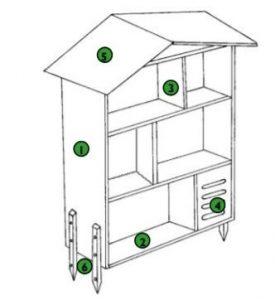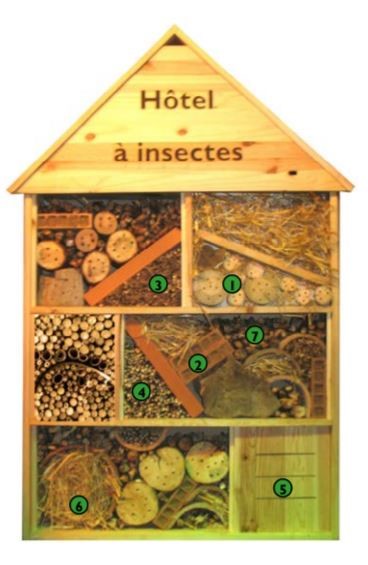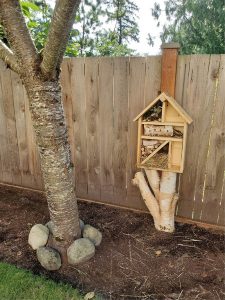
Fall is one of my favorite seasons in the Pacific Northwest. Nature reveals so many colors, scents, and flavors. I see green, brown, and ochre. I smell pine, apples, and cinnamon. I taste pumpkins, pears, and sweet potatoes.
It’s also the time of the year when I set up my garden for winter. And this year I decided to build an insect hotel. An insect hotel is a handmade structure made of recycled or upcycled materials that provides a safe shelter for insects.
Why should you build an insect hotel for your yard?
Insects are an integral part of the ecosystem. Whether they are pollinators, predators, or parasites, each one has an important role to play.
Insects are responsible for the pollination of about 80% of trees and bushes on the entire planet. They play a vital role in the decomposition of animal and plant matter, which is essential for the release of nutrients that are later used for growing plants. Many insects act as biological pest control in the vegetable garden. Some insects break down and recycle plant and animal waste and the bodies of dead animals. Some are an essential part of the food chain for birds, mammals, and fish.
The management of insects, the ecosystem, and their interactions in a sustainable way, is crucial for the survival of all organisms. We must protect them. Some insect pollinators are solitary and don’t live in colonies, so they need a safe, warm, and dry place to build their nests and continue to live.
In addition to being a great environmental project, an insect hotel is a great source of learning for adults and children of all ages. We are all afraid of what we do not know. Having an insect hotel will educate everybody about the crucial role insects have in the ecosystem. By building an insect hotel, we will be able to observe insects, learn about how they live, what they eat, and how they grow so we can get a better understanding of their role. It will also provide social interactions and outdoor activities.
Where should you place an insect hotel?
The best location to build an insect hotel is facing the morning sunrise, against the wind, next to flowers, gardens, or ponds.
How do you build one?
 I’m sharing instructions and tips I received from my cousin, Richard and his wife, Lydie, who are rangers for the National Forests Office in France. Richard provided helpful diagrams of an insect hotel structure.
I’m sharing instructions and tips I received from my cousin, Richard and his wife, Lydie, who are rangers for the National Forests Office in France. Richard provided helpful diagrams of an insect hotel structure.
To build the general structure, you’ll need wooden boards for the sides (see 1 in diagram), base (2), shelves and dividers (3), and roof (5). Be sure to use a resistant wood (like chestnut, larch, or Douglas fir) or bricks and stones for the structure. You can add a wooden board with slots (4) to create a box. You’ll also want to elevate your structure about 20 inches off the ground with wooden stakes (6) or get creative (I used an old tree trunk).
What should you put inside?
To furnish the insect hotel, use a wide range of reclaimed natural materials.
- Old wooden pallets
- Flowerpots: Place these on different angles between the different layers. Leave some pots empty and fill others with straw, leaves, or sand.
- Dead wood, logs, branches, and twigs: These are great to poke into small areas and children will be able to lift up the logs to hopefully reveal centipedes and woodlice.
- Hollow pipes, tubes, and bamboo canes: The different sized pipes will create nesting areas for a wide range of different creatures.
- Dry leaves and loose bark: Add both to the insect hotel. For best results, add in the lower areas of each section as this is suitable for spiders, beetles, and hibernating ladybugs that prefer to stay close to the ground.
Here’s what my cousin, Richard suggests, based on the types of insects you’d like to attract:

| 1 | Pierced logs: wasps and solitary bees | pollinators |
| 2 | Mixture of clay and hay/straw: solitary bees | pollinators |
| 3 | Hollow stems (reeds, bamboo): solitary bees | pollinators |
| 4 | Marrow stems (elderberry, bramble, etc.): solitary bees | pollinators |
| 5 | Box with a few slits, filled with straw: lacewings, including the larvae, feed on aphids, mealybugs, and whiteflies. | predators |
| 6 | Flowerpot filled with straw: earwig, predator of aphids | predators |
| 7 | Stacked dead wood: xylophagous insects, decomposers | “recycler” insects |
How to you care for and maintain an insect hotel?
Let it “bee.” Replace nest and room materials after winter if necessary.
Kids will love building their own insect hotel. Try it, start small, and share your projects with us! Email your photos, along with your name and neighborhood, to Vicki Grunewald, media editor at Highlands Council, to be featured on our website. Your photos may also be shared to our official social media.
As published in October 2020 Connections >
Diagram photos provided by Aline Bloch, created by her cousin, Richard.






